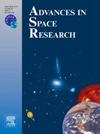Neural network model for predicting the horizontal component of Earth’s magnetic field (H) over Indian equatorial region during quiet and disturbed periods
IF 2.8
3区 地球科学
Q2 ASTRONOMY & ASTROPHYSICS
引用次数: 0
Abstract
Artificial Neural Networks (ANNs) have proven successful in forecasting various magnetospheric and ionospheric parameters. The design of an artificial neural network (ANN) for predicting the horizontal component of Earth’s magnetic field (H) and range in H (ΔH), over Indian equatorial region, for both quiet and disturbed conditions of 23rd solar cycle (August 1996 to December 2007) is discussed in this work. Ground magnetometer data from the stations Tirunelveli [TIR], Pondicherry [PND], Alibag [ABG], and Ujjain [UJJ] are used for training the network. Datasets from the stations Trivandrum [TRD] and Nagpur [NGP] are used for the testing procedure. The data used in this work covers the 23rd solar cycle and it include low, moderate and high solar activity levels of both the ascending and descending phases of the solar cycle. Two sets of input parameters are used as inputs to the ANN. The first set, namely the geophysical parameters, are temporally or spatially related to the training stations. These consists of Latitude, Longitude, day of the year (DOY), local time (LT) magnetic dip angle (Inclination, I) and angle of declination (magnetic declination, D). The second set of inputs, that are driven by solar activity and affect the different stations uniformly, are Solar Flux (F10.7), Ap Index, IMF Bz, and Ion Number Density. Using these input parameters a neural network model (CCNRM) with 10 hidden neurons and 600 iterations is developed. It is found that the prediction accuracy of the model is better while training with original time series rather than the detrended time series. Here we present the prediction of H and ΔH during the quiet, disturbed geomagnetic conditions (minor storms (Dst minimum ≤ −50 nT), major storms (Dst minimum ≤ −100 nT)) along with its seasonal variation. Different datasets of the 23rd solar cycle including low, moderate and high solar activity levels from both the ascending and descending phases of the solar cycle are faithfully reproduced by the model. The model successfully predicted the diurnal variation, seasonal variation, minor storms and major storms within the average error limits of 11 nT, 7 nT, 27 nT and 36 nT respectively during the testing process.
在平静期和扰动期预测印度赤道地区地球磁场水平分量的神经网络模型
人工神经网络(ann)在预测磁层和电离层参数方面已被证明是成功的。本文讨论了在第23个太阳活动周期(1996年8月至2007年12月)平静和扰动条件下,用人工神经网络(ANN)预测印度赤道地区地球磁场(H)水平分量和H (ΔH)范围的设计。来自Tirunelveli [TIR]、Pondicherry [PND]、Alibag [ABG]和Ujjain [UJJ]站的地面磁强计数据用于训练网络。来自Trivandrum [TRD]和Nagpur [NGP]站点的数据集用于测试过程。本研究使用的数据涵盖了第23个太阳周期,包括太阳周期上升和下降阶段的低、中、高太阳活动水平。两组输入参数被用作人工神经网络的输入。第一组,即地球物理参数,在时间或空间上与训练站相关。这些输入包括纬度、经度、一年中的一天(DOY)、当地时间(LT)磁倾角(倾角,I)和赤纬角(磁偏角,D)。第二组输入由太阳活动驱动,对不同台站的影响是均匀的,它们是太阳通量(F10.7)、Ap指数、IMF Bz和离子数密度。利用这些输入参数,建立了一个包含10个隐藏神经元、600次迭代的神经网络模型。结果表明,使用原始时间序列训练比使用去趋势时间序列训练的预测精度更高。本文给出了安静、扰动地磁条件下(小风暴(Dst最小值≤- 50 nT)、大风暴(Dst最小值≤- 100 nT) H和ΔH的预测及其季节变化。模型忠实地再现了第23个太阳周期的不同数据集,包括太阳周期上升和下降阶段的低、中、高太阳活动水平。在试验过程中,该模式成功预测了日变化、季节变化、小风暴和大风暴的平均误差范围分别为11 nT、7 nT、27 nT和36 nT。
本文章由计算机程序翻译,如有差异,请以英文原文为准。
求助全文
约1分钟内获得全文
求助全文
来源期刊

Advances in Space Research
地学天文-地球科学综合
CiteScore
5.20
自引率
11.50%
发文量
800
审稿时长
5.8 months
期刊介绍:
The COSPAR publication Advances in Space Research (ASR) is an open journal covering all areas of space research including: space studies of the Earth''s surface, meteorology, climate, the Earth-Moon system, planets and small bodies of the solar system, upper atmospheres, ionospheres and magnetospheres of the Earth and planets including reference atmospheres, space plasmas in the solar system, astrophysics from space, materials sciences in space, fundamental physics in space, space debris, space weather, Earth observations of space phenomena, etc.
NB: Please note that manuscripts related to life sciences as related to space are no more accepted for submission to Advances in Space Research. Such manuscripts should now be submitted to the new COSPAR Journal Life Sciences in Space Research (LSSR).
All submissions are reviewed by two scientists in the field. COSPAR is an interdisciplinary scientific organization concerned with the progress of space research on an international scale. Operating under the rules of ICSU, COSPAR ignores political considerations and considers all questions solely from the scientific viewpoint.
 求助内容:
求助内容: 应助结果提醒方式:
应助结果提醒方式:


